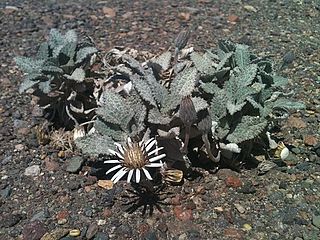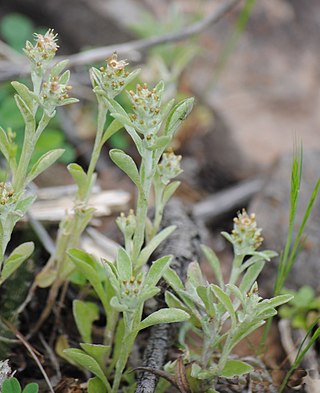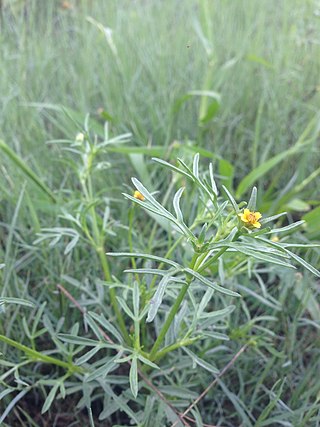
Hypoxis decumbens is a species of plant in the Hypoxidaceae, considered by some authors to be included within the Liliaceae or Amaryllidaceae. The species is widespread across South America, Central America, Mexico, and the West Indies.

Acanthospermum hispidum is an annual plant in the family Asteraceae, which is native to Central and South America. This plant is cited as a weed in cotton culture in Brazil, and it is also used as a medicinal plant. It is also naturalized in many scattered places in Eurasia, Africa, and North America It is naturalized in Australia and is a declared weed in Western Australia.

Dalechampia dioscoreifolia is a species of plant in the family Euphorbiaceae first described in 1841. It is native to Central America and northern and western South America.
Thoracocarpus is a genus of plants first described as a genus in 1958. It contains only one known species, Thoracocarpus bissectus a hemiepiphytic vine. It is native to Costa Rica, Panama, Cuba, Trinidad and Tobago, and South America.

Bidens laevis is a species of flowering plant in the daisy family known by the common names larger bur-marigold and smooth beggarticks. It is native to South America, Mexico, and the southern and eastern United States. It grows in wetlands, including estuaries and riverbanks.

Heterosperma is a genus of flowering plants in the sunflower family, native to North and South America.

Urmenetea is a genus of South American plants in the family Asteraceae.
Milleria is a genus of flowering plants in the tribe Millerieae within the family Asteraceae.

Aechmea angustifolia is a plant species in the genus Aechmea. This species is native to Central America and northern South America.

Tagetes subulata is an herbaceous plant of the family Asteraceae. It is widespread across most of Mexico, and found also in Central America, Colombia, and Venezuela. It has highly divided bright green leaves and yellow flowers contained in an elongated calyx.
Euterpe catinga is a palm species in the genus Euterpe. It is found in forests of a dry, sandy soil and very peculiar vegetation, known as catinga forests or Campinarana in northern South America.
Diastatea is a genus of plants native to Latin America, mostly in Mexico and Central America but with one species extending southward along the Andes to Argentina.
- Diastatea costaricensisMcVaugh - Guatemala, Honduras, Nicaragua, Costa Rica
- Diastatea expansaMcVaugh - central Mexico
- Diastatea ghiesbreghtii(Kuntze) E.Wimm - southwestern Mexico
- Diastatea micrantha(Kunth) McVaugh - widespread from central Mexico to the Jujuy region of northern Argentina
- Diastatea tenera(A.Gray) McVaugh - southern Mexico and Guatemala
- Diastatea virgataScheidw. - southern Mexico

Macroscepis is a genus of plants in the family Apocynaceae, first described as a genus in 1819. It is native to Latin America and the West Indies.
Brickellia diffusa is a Latin American species of flowering plants in the family Asteraceae. It is widespread across much of South America, Central America, Mexico, Galápagos, and the West Indies. Its distribution stretches from Sonora and Tamaulipas in northern Mexico to Jujuy in northern Argentina.
Cotula mexicana, also known as Mexican brassbuttons, is a plant species in the sunflower family. It is widespread in South America and also found in central Mexico and parts of the United States.

Elephantopus mollis, common names tobacco weed, and soft elephantsfoot, is a tropical species of flowering plant in the family Asteraceae.
Tagetes campanulata is a South American species of plants in the family Asteraceae. It is found in Argentina and Bolivia.

Flaveria bidentis, the coastal plain yellowtops, is a South American plant species of Flaveria within the family Asteraceae. It is native to South America, and naturalized in many places.

Gamochaeta pensylvanica, the Pennsylvania cudweed or Pennsylvania everlasting, is a widespread species of flowering plant in the family Asteraceae. It is native to South America and introduced into Eurasia, Africa, Australia, and North America. The pensylvanica epithet is a misnomer, as the plant is not native to Pennsylvania and only marginally naturalized there.

Heterosperma pinnatum, the wingpetal, is a New World species of plants in the sunflower family. It has a discontinuous distribution in North and South America, having been found in Bolivia, Venezuela, Mexico, Guatemala, Honduras, and the south-western United States,













